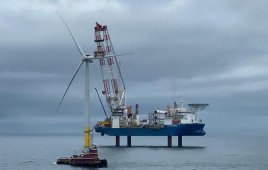Carey C. Jordan, Partner, McDermott Will & Emery, www.mwe.com
A recent case concerning intellectual property (IP) rights serves as a cautionary tale to researchers and inventors in the wind industry. Although the case centers around a Stanford University researcher and several patents he authored concerning HIV nucleic acid measurement, it is useful to the wind industry which also receives government funding. The issue is serious enough to be brought before the supreme court.
Stanford University researcher Mark Holodniy had an agreement with the college, which included language that he would “agree to assign” patent rights to it. However, he also had a consulting agreement with a small start up company that collaborated with the university on the research, and stated he would assign intellectual property rights to them.
Carey Jordan, a partner at the Energy & Chemicals IP practice group of McDermott Will & Emery, sheds some light on the case. She explains that when Holodniy used the wording “I will assign my rights” with Stanford, it was just a promise, not an actual assignment to the university. Later, when he went to work for the second company and signed another document that stated “I do assign my rights,” it was more of a contract.
Herman LaRoch eventually bought the company. Stanford tried to negotiate with him, claiming the university owned the patents because of Holodniy’s promise, so he must buy them for royalties. LaRoch claims Holodniy had assigned rights to him, and so the university’s claim was baseless. Stanford in turn said because the work was done with government funding, it was privy to the government’s rights, should they have any. In other words, they were saying, “we have rights that make your right ineffective.”
“The language ‘will assign’ was not viewed by the court as an actual assignment,” Jordan says. “It was viewed as a promise to assign in the future. So for Holodniy to assign his invention to Stanford, he would have had to execute an actual assignment later.” That means there is a difference in promising you will do something and actually doing it, as Jordon notes. It just needed to be said clearly in a letter that the IP is now the property of Stanford. “It’s similar to when you sell your house,” she says. “The deed transfers and so does the ownership of the house.” Holodniy would have signed a document called an assignment, in effect saying “my rights in these events hereby go to Stanford, and the university now holds this up.”
Jordan expects the Supreme Court will discuss government rights and implications under the Bayh-Dole Act. The legislation was written to facilitate technology transfers outside of research because, at the time, the government was involved in a lot of funding, which produced many patents. “The act was written to foster development that could be commercialized so more people benefit,” she says. “But under the act the government would retain certain rights.” It looks as if in the federal circuit appellate court decision, the Bayh-Dole Act does not apply anything, meaning the assignment to LaRoch was perfectly legal. The Supreme Court will decide whether it was or not. “What is interesting is that the Court will interpret the act, which they have not done before,” she says.
Jordan explains the situation isn’t so much about the taking of rights, but a tale of warning to anyone who receives government funding in the course of doing research. A letter of intent is not enough to determine when rights transfer. The promise to sign came first in this case and the “hereby assign” was the actual assignment. This is especially applicable to the renewable energy industry, such as wind power, where more grants are available. “If you take the government’s money, the government has certain rights under the agreements. The Supreme Court opinion will decide whether Stanford properly managed its investors’ rights,” she says. Stanford apparently did not have proper agreements in place. They’re in a pickle and the Bayh-Dole Act doesn’t save them. So unless the Court says it will, which Jordan says is unlikely, Stanford is out of luck. The Court will announce its decision about June 2011.
Jordan recommends that all inventors have some employment agreement so there is no uncertainty as to who owns IP. Looking at the wind industry in particular, anyone doing research on a project or developing technology should make sure those doing the developing have signed an agreement to assign the rights to it. Researchers must be careful that the agreement with their inventors, scientists, and technicians are sound in transferring the rights of inventions to the company, or they could find themselves in the same pickle.
WPE
Filed Under: Policy





